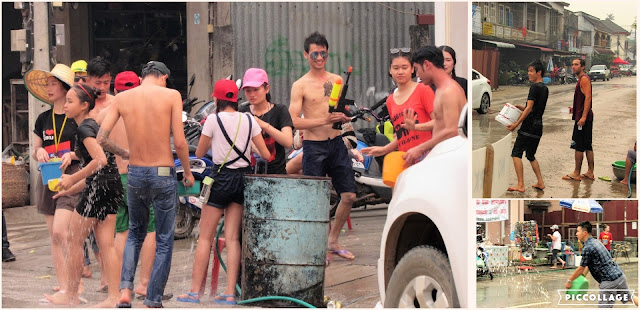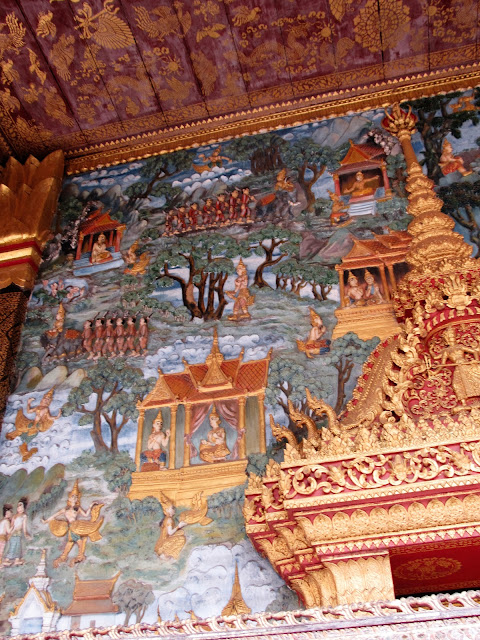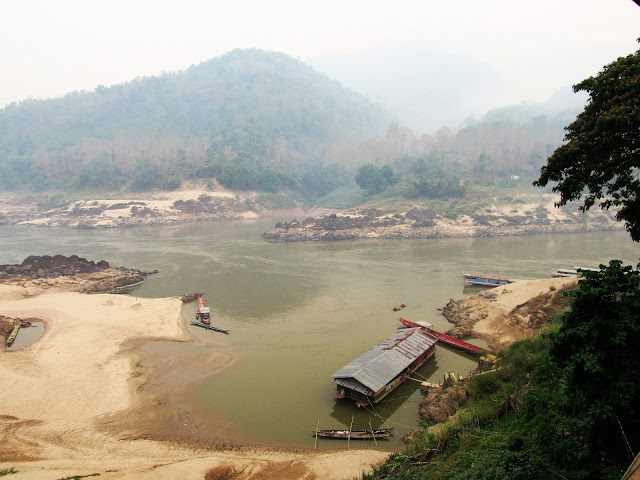Transparency: This post is being written in 2020 as we did not have a blog in 2016. I am using stay at home time to flatten the curve of the global pandemic Covid-19 to organize photos from this trip into a post. Memories may not be exact.
Hanoi (Again)
Paul's Dengue is well and truly gone so we can now do some sight-seeing in Hanoi ... such a pretty city. We were treated so well in the guest house when Paul was sick that we head there again.
View from our window:
This capital city of Vietnam with a population of 8.1 million people on the banks of the Red River delta was founded in 1010 as the capital of Imperial Vietnam. When the country was colonized by the French, it became the capital of French IndoChina. The Old Quarter of Hanoi is very walkable.
At the heart of Hanoi is peaceful Hoan Kiem Lake (Lake of the Restored Sword). Many people enjoy walking around the lake, resting on the benches and visiting the temple. While resting some school kids approach as they did in Ho Chi Minh to interview us for a school project. We oblige as they are fun to talk with.
We spend almost an entire day in the Vietnamese Womens' Museum on Ly Kiet Street near the Lake.
Its fascinating because each of the 28,000 objects in the museum is connected to a particular woman, thus making the exhibits very real and emotional. The objects are divided into collections such as wood, fabric, etc. There are three permanent collections (Women in Family - Women in History which includes their role in resistance movements & Women in Fashion). Then there are Special Exhibitions that change regularly and Online Exhibitions such as the one on Women Street Vendors.
There are 52 different ethnic groups in Vietnam and the museum worked hard to represent all.
Many of the photos here had to be taken through glass, so they are either grainy, have reflection or were simply impossible to take. So this post is not a reflection of the great diversity of displays actually in the museum.
Many Vietnamese women engage in small business on either a full or a part-time basis that includes the sale of agricultural and/or craft products, utensils, food, drink, etc. The products are sold from home, in a market or on the roadside. Markets vary in location and frequency depending on geography such as floating markets; once a week markets in remote mountain villages; or daily markets in the cities either by day or night. Goods can be carried in baskets on the head or baskets on a shoulder yoke, on bicycles, on beasts of burden or in push carts. Markets also serve as a social and cultural exchange. Women are often caring for infants and/or children as they go about their business.
Women laboured in agriculture doing many jobs. Below women are working in the rice fields:
In many of the ethnic groups family structures are patrilineal. Most couples are now monogamous, but in the past polygamy was common. Couples today are having fewer children than in the past. The groom's family pays a major role in the selection of a partner, in the marriage rituals and the bride usually goes to live with the groom's family.
Wedding clothes from two different groups:
 |
| Girls learning embroidery from a young age |
I am particularly interested in jewelry, so the photos below in the fashion section caught my eye.
Women not only fought in wars, but many thousands more were cooking to feed soldiers and were providing first aid and nursing/medical care to injured soldiers.
Below are some photos of fashion amongst various ethnic groups and through the ages that I could actually get photos of. The fashion collection at the museum is huge.
As usual there is so much more that could be seen and done in and around Hanoi, but time beckons.
People work long, hard hours in Vietnam. One thing we loved about the cities in particular is how generations of families come together for dinner. Often a child's table and little kids chairs are moved out onto the sidewalk. To earn a little extra, there would often be enough food to sell to others. This is where and how we liked to eat, with families on the street. Some people speak English, other conversations were sign language.
Our kind guest house host again shows his generosity. We give him the last of our Vietnamese dong currency and he trades it for us for the Laotian kip so that we will have money for the journey. We also leave our passports with him and he obtains a visa to Laos for us. No charge for him doing this.
We take a quick, inexpensive flight from Hanoi to Luang Probang. There are some political issues in Laos just now. On the major highway to Luang Probang a bus was hijacked and some tourists killed, thus the flying.
Luang Probang: (The Heart of Laos)
Here's another example of us as newbie travelers. We arrive and its the start of the Songkran (New Year's) Water Festival - we had no idea. Note to Self: research needs to include holidays and festivals. We were lucky to find a room. But it does impact everything we do or don't do. A search shows that Songkran lasts two to three days. Perhaps because Luang Probang is the capital city, it stretches out for the entire week that we are there.
Apparently we missed the beauty pageant and the crowning of Miss Pi Mai Laos (Miss Laos New Year).
In the old days people would carry bowls of perfumed water to sprinkle on friends or monks to give new years blessings for long life. Its a time for families to get together to express gratitude to elders, to visit temples and give offerings.
Many people sit on the street all day making and selling garlands out of marigolds for people to take to temple alters and/or to decorate Buddhist images or even buildings. Their spiritual significance brings taxi drivers to hang them in their vehicles.
Today the water comes by the bucketful from plastic lined pick up trucks; from hoses; from huge water canons. There is no perfume, only vibrant colours: red, green, blue or pink in the water.
 |
| Lookin' for fun |
The next two photos are right across the street from our guest house:
The young have taken over and the meaning of the celebration seems to be lost. There are pick up trucks that are speakers on wheels blasting music at crazy volumes.
One fabulous thing that we stumbled on when out for a walk was a parade. Not just any parade. Villages from all over the country were represented here in their ethnic costumes. We were standing by a Laotian women who now lives in California but who comes home for Songkran. She kindly explained everything to us as the parade passed. It took almost two hours for the whole parade. We did not have our camera with us. (Sob)
We do capture what we later realized were some preparations for the parade:
When we first arrived before so many people came to the city and the celebrations really went wild we managed to visit the day market, the Handicraft night market and the Royal Palace Museum (Haw Kham).
Some incredible jewelry in a store on the way to the market. The earrings in the centre are the ones I get:
Lots of natural and herbal remedies are available at the market:
Royal Palace Museum
The royal palace was built in 1904 during French colonial rule. First a king, then a crown prince ruled from there. Of course when the communists took over, the royal family was sent to re-education camps as all the elite and educated were. Some time after that the palace was turned into a museum. There is a beautiful temple on the grounds.
At one place gleaming silver nagas offer protection while at other entrances, the nagas are gold inset with green glass
Many people are visiting the palace on the day we are there so photos are almost impossible to take. The floor-to-ceiling painted walls have to be seen to be believed ... such detail. Beautiful furniture is everywhere.
The first sight to greet us is supposed to be a bear sanctuary to prevent the bears being killed for their gall bladders. There are signs educating people that to kill a bear for this reason is wrong. One is never really sure if its a rescue centre or something for tourists. The bears are very comfortable, hanging about in hammocks.
The next thing we notice is that, yes, this is a holiday and families are all here together, packing picnics into the falls. Young men don't carry 24's of beer as would be done in Canada - here its 24's of Red Bull.
This really is a great place to escape the heat and spend a day. You can hike, swim or just lounge around and watch others:
After walking the lower trails ...
... we decide to see if you can hike up the mountain to overlook the falls which is where some of the above photos were taken from. Looking around we don't see any trail markers. We do see something that goes almost straight up. It looks like a waterfall used to tumble down here, but dried up. Well - rock climbing 101 begins! Finally we get up there. There's a road and a nice easy trail down!! Of course!! At least we get to go down the easy way.
On the way down we see this little cutie cooling down, giggling as he enjoys every minute:
On the way back to town we stop at a sawmill to take some photos for the Freer's back home who are in the logging business.
Well, its time to say goodbye to Luang Prabang. Its too bad we didn't get to see more of Laos. One day we will make it to the south of the country. Now we are taking a "slow boat" (2 days on the Mighty Mekong) from Laos to Thailand.
We go have a look at the river. These are the type of boat we will be in:
The River Journey
Our boat may have open sides, but at least it has a roof. Others really travel open:
On the other hand we are warned to not take a fast boat. People die frequently in accidents when one of these flips. Some people wear motorcycle helmets in them.
Many villagers who live along the river have come to Luang Prabang for Songkran. They are headed home now loaded down with goods from the city. Slow boats are inexpensive and of course where they live is mostly water-access only.
You will notice that many of the pictures appear to be foggy or hazy. That's because its the season when farmers all along the Mekong are following the ancient custom of burning their fields to plant new crops.
There are of course no docks for the boat to pull up to go that people can embark and disembark with ease. Here are a couple of places where people get off the boat with all of their goods:
We pass several types of homes, farms and floating homes that can be seen from the water. From what we can see here it looks like people on the Mekong who live in floating homes, do so each family on their own. We don't see any floating villages like in Vietnam.
 |
| A camp of some sort? Permanent? Temporary? Just a work site? |
Elephants are supposed to be protected now from working, but this elephant high on the hillside is clearly working at logging:
At dinner time we arrive in Huay Xai which is the border town on the Laos side. Here we overnight. We walked around the town which wasn't particularly attractive. I don't remember what the border crossing procedure was.
Getting off the boat in Laos, it doesn't take too long to find a guest house where we get a room. The young people on the boat all head for a hostel and have already decided who will share a room with whomever they just met on the boat, to lower travel expenses even further.
The boat from Luang Prabang to the border town of Huay Xai was comfortable enough with tables that four could sit around. We shared with two young women. The boat is home to the family that runs it. The woman has prepared a bit of food and has drink that we can purchase.
The boat from Huay Xai to the border town of Chiang Khong in Thailand for the second part of the trip on the other hand was not so comfortable. There were no tables, just hard wooden benches and very little, if anything to eat or drink available for purchase.
View over the Mekong from the restaurant we eat at in Huay Xai:
I remember that as the night sky darkened we were able to see flames from burning of the land.
More scenes from along the river:
Some devout people have mounded up sand into a stupa and decorated it. At New Year's this is a common way for people to make merit with the monks. In the towns and cities, people haul sand from the river or the sea banks to the temples to make stupas.
 |
| Boys playing |
Young monks bathing in the river. We can't see the temple from the river.
It looks as though a few families may live in this one area. Chickens running around:
By the time we land in Chiang Khong, Thailand we are eager to get off of the boat. The thrum of the big, noisy, smelly diesel engine is a relief to get away from. Its been an interesting trip, but I wouldn't do it again or even particularly recommend it to others, at least not at this time of the year when the fields are burning and not if you have only a short vacation.
Unfortunately there is no time to look around Chiang Khong, our mini van awaits. It's reputed to be a pretty 'destination' town.
So here we are - off to Chiang Mai.








































































No comments:
Post a Comment